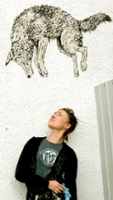Cate Francis holds BFA from the University of Saskatchewan (2008), an MFA from the Nova Scotia College of Art and Design (2014) and a Prairie Horticulture Certificate from the University of Saskatchewan CCDE (2015). She has shown work in galleries across North America and her work has been published in national publications including Applied Arts, Grain Magazine, and the Antigonish Review.
Though the majority of her practice is based in representational drawing and traditional printmaking, since 2015 she has focused on combining her interests in art and ecology into collaborative community engaged art projects and public murals. Most of her public art is carried out under the umbrella of the Paper Wildlife Conservancy, which is a city wide wheatpaste campaign with the goals of engaging Saskatoon residents with the local ecology, architecture and fostering a positive awareness of street art in the city.
In addition to her art practice, Cate is an instructor at Void gallery and drawing instructor the Community Arts Program at the University of Saskatchewan. She volunteers her time in the community as a weekly radio DJ on CFCR and executive board member of Void Gallery. She must secretly really like meetings, as she can often be found sitting on committees for several arts organizations throughout the City.
Cate on teaching: I focus on developing a solid foundation of technical skills so that students can confidently work towards developing their own personal artistic vocabulary and practice. Developing a proficiency in both technique and conceptualization takes practice, practice (and more practice) as well as the ability to seek out and utilize feedback from instructors and peers. To this end I try my best to approach each student at a level where they are comfortable during in class work periods, one on one meetings and informal group discussions. To help facilitate a comfortable learning environment, I typically begin studio class with warm up exercises, emphasizing that there are no mistakes, only opportunities to learn, backed with an expectation of hard work, openness and respect. Though the majority of class time is spent hands on, I often introduce new techniques and projects with short slideshows highlighting both contemporary and historical applications of a technique or concept, and encourage others to share their own interests and inspirations with the group. I believe that exposing students to a range of possibilities helps them locate their own work within a broader social and cultural context.
